
Arts Square is a square in the center of St. Petersburg, which, as part of the surrounding development, is included in the UNESCO World Heritage List.
The Arts Square has a rectangular shape in plan and is bounded by Italian and Engineering Streets.
The history of this place as a square dates back to 1819, when the Mikhailovsky Palace, designed by architect Carlo Rossi, began to be built nearby. Since 1825, the same architect created a single ensemble of buildings surrounding the palace, in the center of which Mikhailovskaya Square (now Arts Square) was created. In 1834 , also according to Rossi 's project , between Mikhailovskaya Square and Nevsky Prospekt was laid Mikhailovskaya Street, which opened the prospect of the Mikhailovsky Palace.
In the early 1920s, the square was named Lasalle Square, in honor of the German socialist Ferdinand Lasalle. And since September 26, 1940, the square has had its current name - Arts Square, according to the cultural and art institutions located on the square.
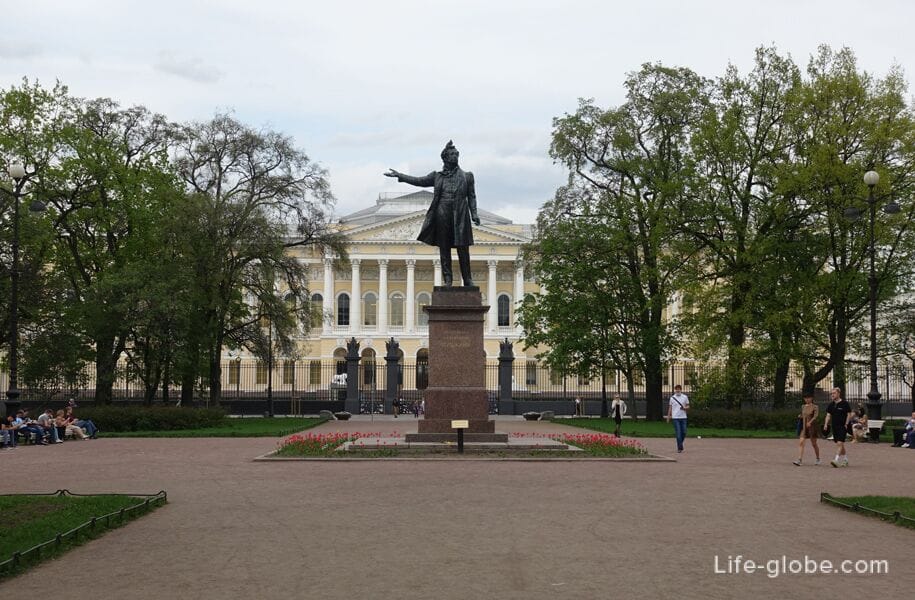
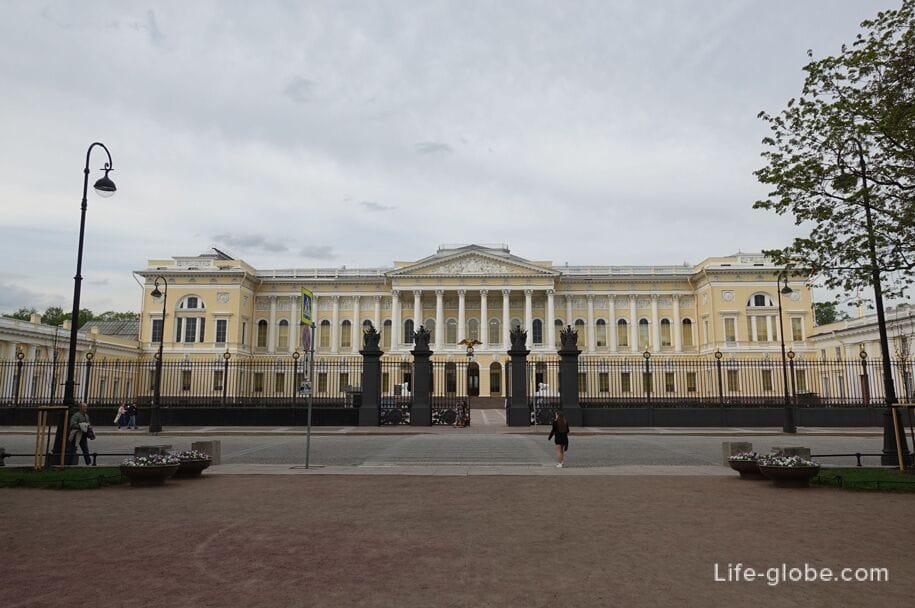
The center of the square is an oval square (Mikhailovsky Square), which was laid out in 1827-1828 by the architect Rossi.
Today in the square there are: lawns, flower beds, paths and places to relax.
In the center of the square, on a high four-sided, polished red granite (the base is made of forged granite) pedestal, there is a monument to the Russian poet Alexander Sergeevich Pushkin. This is the work of sculptor M.K. Anikushin and architect V.A. Petrov, installed in Mikhailovsky Square in 1957.
Alexander Sergeevich is depicted in the monument in all its glory and creative impulse.

Along the perimeter of the Arts Square there is an ensemble of historical buildings, created, basically, by the architect Karl Rossi in the first half of the 19th century. Even with further construction on the square, architects used projects of facades of houses designed by Rossi.
The houses in the ensemble of the square are architecturally similar, the details of the design of the facades, their height, the style features and the location of the window openings coincide.
The main decoration of the Arts Square is the Mikhailovsky Palace, built in 1819-1825 by architect Carlo Rossi, on the site of the adjacent garden (now Mikhailovsky Garden).
The Grand Ducal Palace was erected by order of Emperor Alexander I for Grand Duke Mikhail Pavlovich. Mikhail Pavlovich is the fourth son of Emperor Paul I and Maria Feodorovna, the younger brother of Emperors Alexander I and Nicholas I.
The palace has a late classicism style. Its front (southern) facade faces the Arts Square and is decorated with an arcade and a Corinthian colonnade. The portico of the facade is topped with a triangular pediment.
In the walls of the former palace, you can visit the restored palace halls, the State Russian Museum is located here.
Address of the Mikhailovsky Palace: Engineering street, 4. More about the Mikhailovsky Palace...


Next to the Mikhailovsky Palace, on the Arts Square and the embankment of the Griboyedov Canal, there is the Benois building, which is connected by a special passage to the wing of the Mikhailovsky Palace and is also part of the Russian Museum.
The project of the Benois building was carried out in 1910-1912 by architects Leontiy Nikolaevich Benois and Sergey Osipovich Ovsyannikov. The laying of the building took place on June 27, 1914. Construction was completed in 1919.
The Benois building houses permanent exhibitions of art from the late 19th and early 21st centuries, as well as halls for temporary exhibitions.
Address of the Benois building: Engineering Street, 2 / Embankment of the Griboyedov Canal, 2.
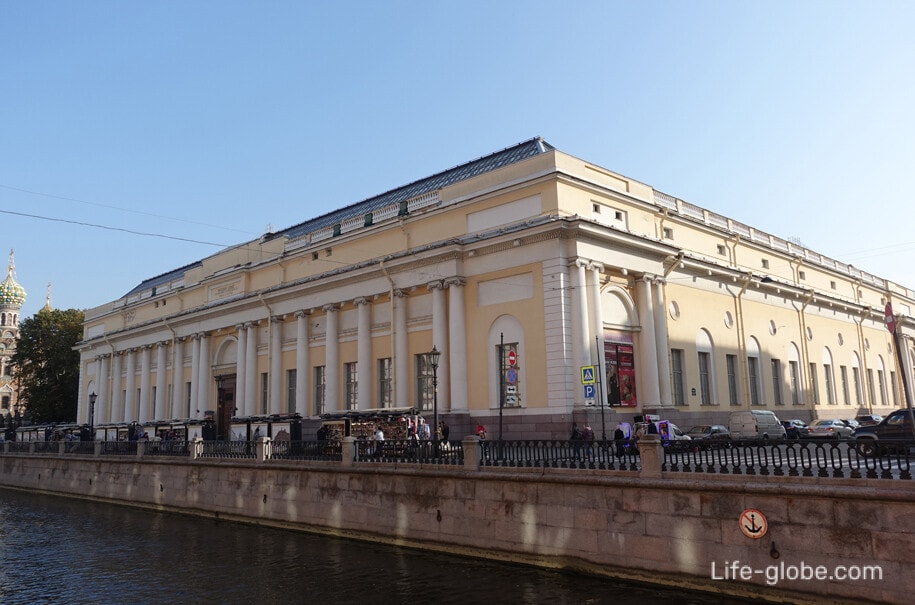
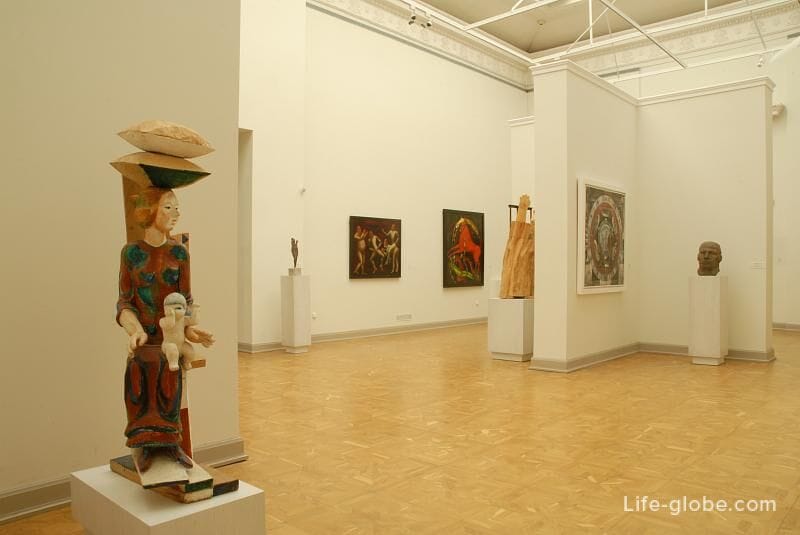
On the eastern side of the Mikhailovsky Palace is adjacent to a historical building in the style of Russian neoclassicism, built in 1902-1913 by the architect of the Imperial court V.F. Svinyin to display ethnographic collections.
Today it is the Russian Ethnographic Museum, which is one of the largest ethnographic museums in the world.
The address of the Ethnographic Museum: 4/1 Engineering Street. More about the Russian Ethnographic Museum...

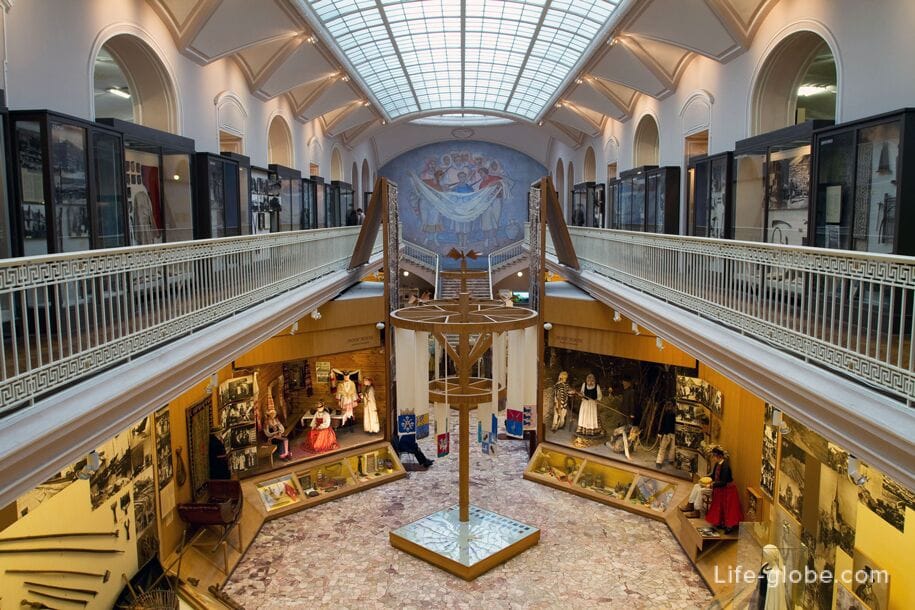
The Mikhailovsky Theater building was built in 1831-1833 by architect Alexander Bryullov using Rossi's designs in order for the theater building to fit into the overall composition of the Arts Square.
In 1859, architect Albert Kavos rebuilt the building, expanded the stage and added a tier in the auditorium. During this restructuring, the Mikhailovsky Theater received a ceiling lamp by the Italian artist Giovanni Busatto "The Victory of the forces of enlightenment and science over the dark forces of ignorance."
The theater has a modest exterior finish. The interior of the theater radically contrasts with the exterior - it abounds in silver, velvet, mirrors, crystal, paintings and stucco.

On the 2nd tier of the theater there is the Mikhailovsky Theater Museum, which tells about the history of the theater and whose exhibits reflect the most important events of the oldest musical group of the city.
In the museum: posters, sketches of scenery and costumes created by the best theater artists, prints depicting the faces of those who determined the success of the theater in the past, photographs that preserved interesting rehearsal and stage moments, costumes and author's layouts.
Address of the Mikhailovsky Theater: Arts Square, 1.
Mikhailovsky Theater website: mikhailovsky.
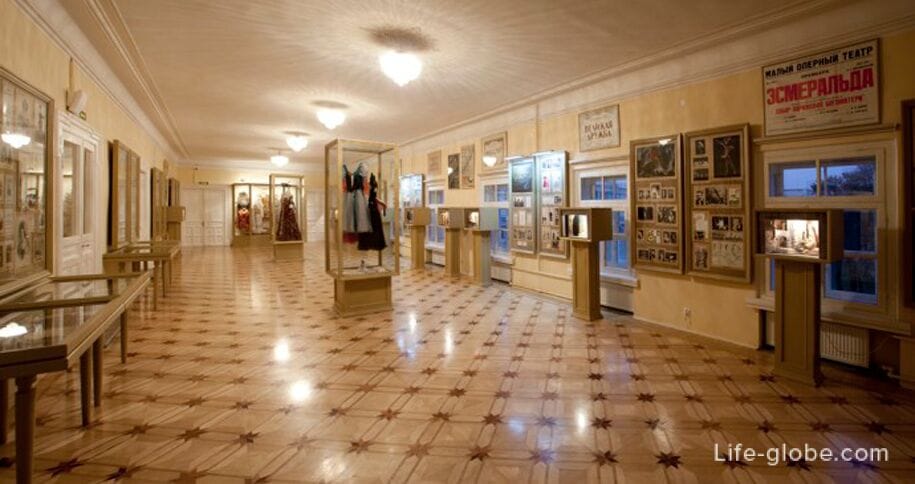
The building was built in the 1820s by architect K.I. Rossi for the military Governor-General of St. Petersburg - Count Pavel Vasilyevich Golenishchev-Kutuzov.
During the history, the owners and interiors of the building have changed.
Today the building is an architectural monument, has 3 floors and some decorations on the facade.
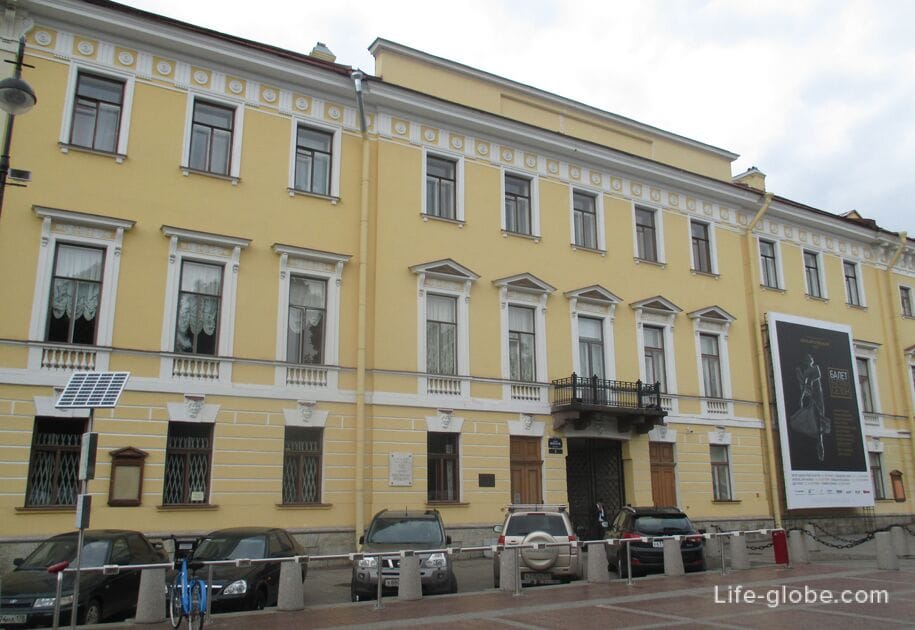
In 1924-1939, the painter Isaac Israilevich Brodsky, a famous artist and favorite student of Ilya Yefimovich Repin, lived in the house.
In 1949, the Brodsky memorial museum-apartment was opened here, where a collection of works by Russian artists collected by Brodsky, as well as his own works, is now presented. Memorial items have also been preserved: furniture, books, autographed photographs of many famous people.
Temporary exhibitions are held in the museum's exhibition hall. On the second floor, in the workshop, in the hall with magnificent acoustics, where in the 19th century the evenings of the musical and literary salon of the Counts of Vielgorsky were held, vocal and instrumental chamber concerts of classical music are held.
The Brodsky Museum is part of the Museum of the Academy of Arts. Website: artsacademymuseum.
Building address: Arts Square, 3.
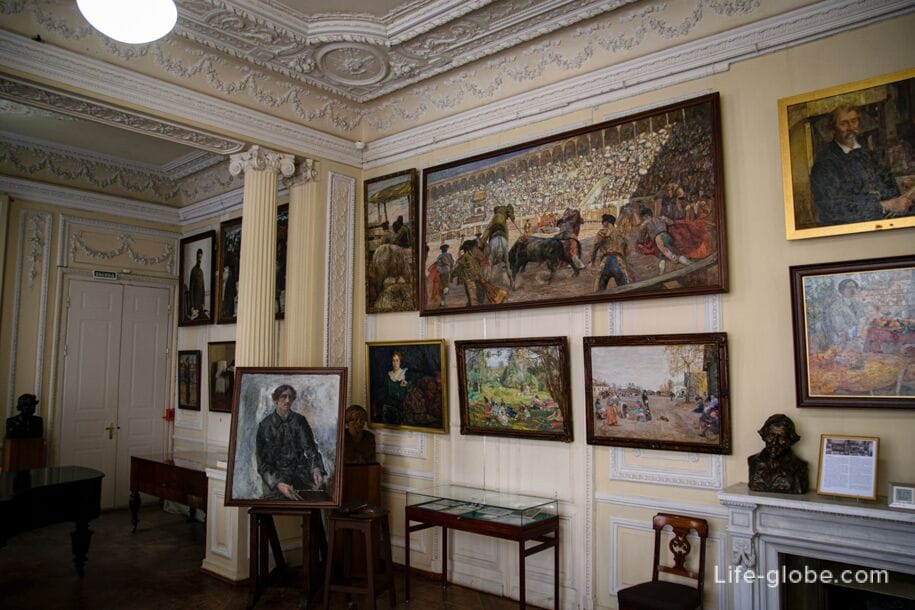
It was the architect P.P. Jaco's own apartment house, built in 1831, and, of course, using the facade design by K.I. Rossi.
The building was built in 1862-1863 by the architect I.D. Corsini. In 1990-1991, the building was rebuilt with the facades preserved.
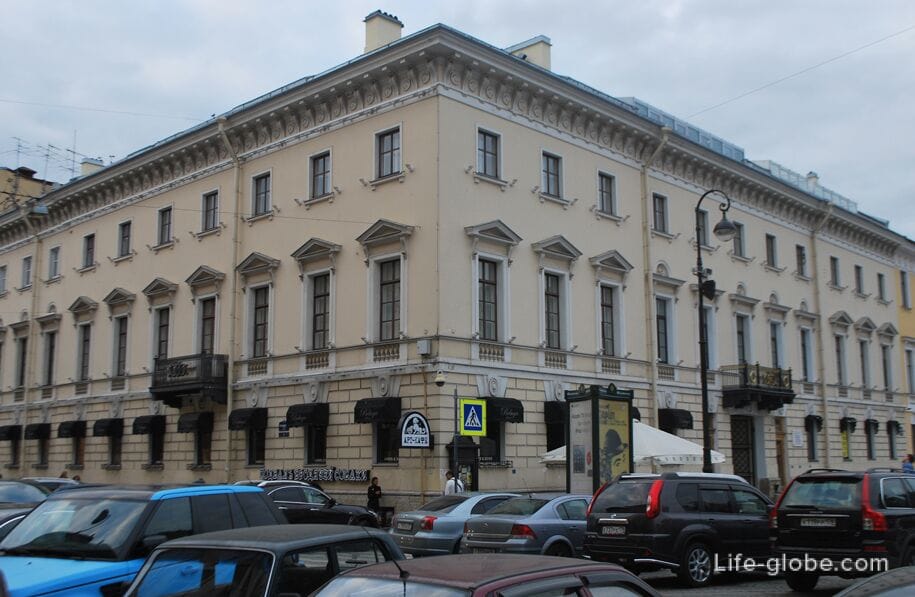
From December 31, 1911 to March 3, 1915, the literary and artistic art cabaret "Stray Dog" was located in the basement of the building. Today it is an art cafe "Basement of a Stray Dog", where musical and poetic evenings, performances and exhibitions are held.
Art cafe website: vsobaka.
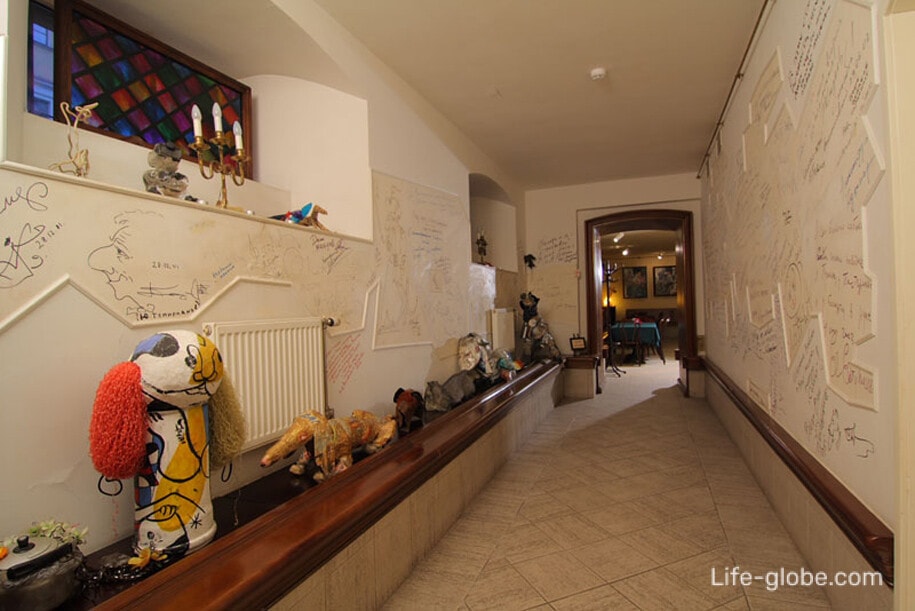
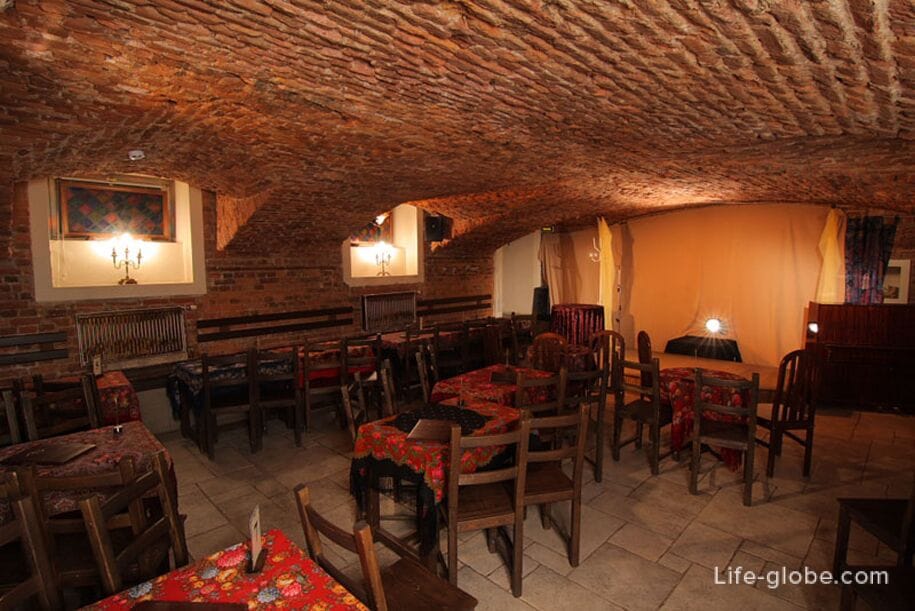
The Jaco House is a corner building facing Arts Square, 5 and Italianate Street, 4.
Near the building, on the Italian street, there is a famous monument to Ostap Bender. More about the monument to Ostap Bender...
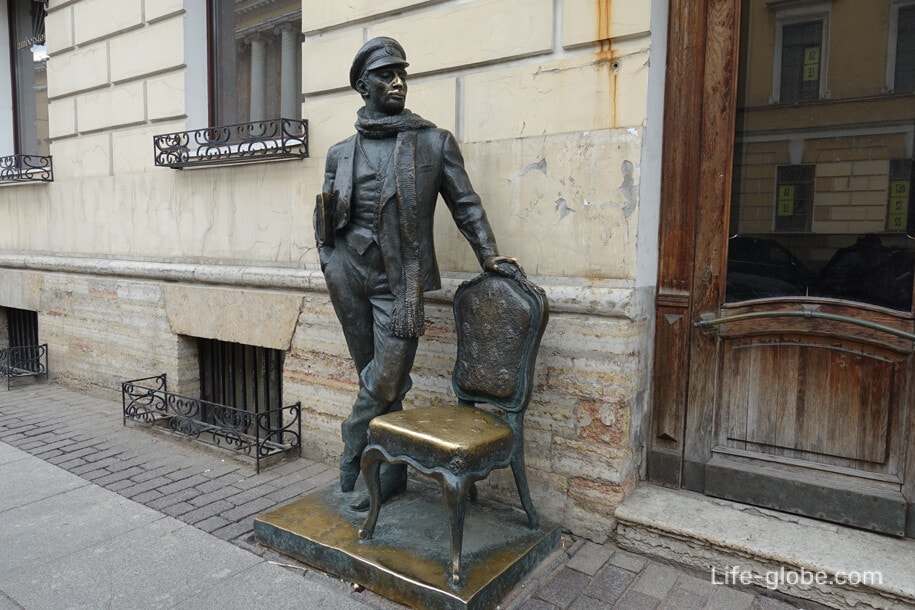
Near the square, on the site belonging to the Church of St. Catherine, residential buildings were built in the 1840s according to the project of architect P.P. Jaco.
Address: Italian street, 5.
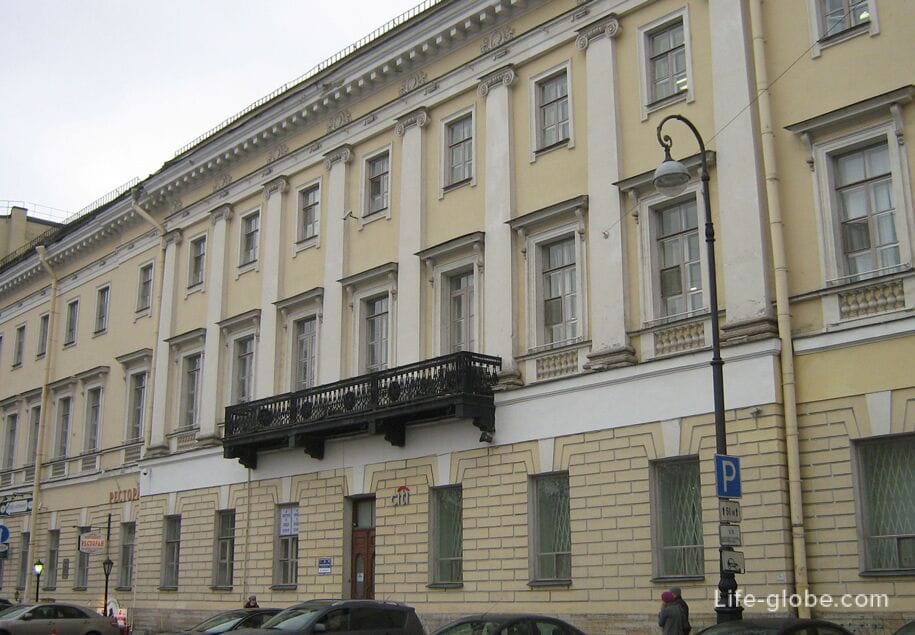
The 5-star Belmond Grand Hotel Europe, whose facades overlook Arts Square, Mikhailovskaya Street and Nevsky Prospekt, is housed in a historic building originally built at the end of the 18th century.
In 1823-1825, the reconstruction of the old and the construction of new stone houses on the site was completed. Another reconstruction, designed by K.I. Rossi, took place in 1826-1830.
In the second half of the 19th century, the buildings were converted into an eclectic hotel. Subsequently, alterations, superstructures and alterations of the building were also carried out. The building was used for various purposes, until in 1945, after renovation, it began to function again as a hotel.
Today, within the walls of this historic vast building, 5-star "Belmond Grand Hotel Europe" (link to the hotel), which in 2009 at the World Travel Awards ceremony in London was named the most luxurious hotel in Europe and the world.
The hotel's facilities include a concierge, a bar, a fitness center, a spa and wellness center, free Wi-Fi and parking, facilities for disabled guests, a tour desk, an ATM, conference rooms with the latest audio and video technologies, as well as 5-star business services.
The stylish and luxurious rooms of the hotel have all modern amenities, including satellite TV, mini-bar, safe and air conditioning. The private bathroom is equipped with bathrobes, slippers, a hairdryer and free toiletries.
A buffet breakfast can be included in the room rate. Link to the hotel
Hotel address: Mikhailovskaya Street, 1 / Italianskaya Street, 7.

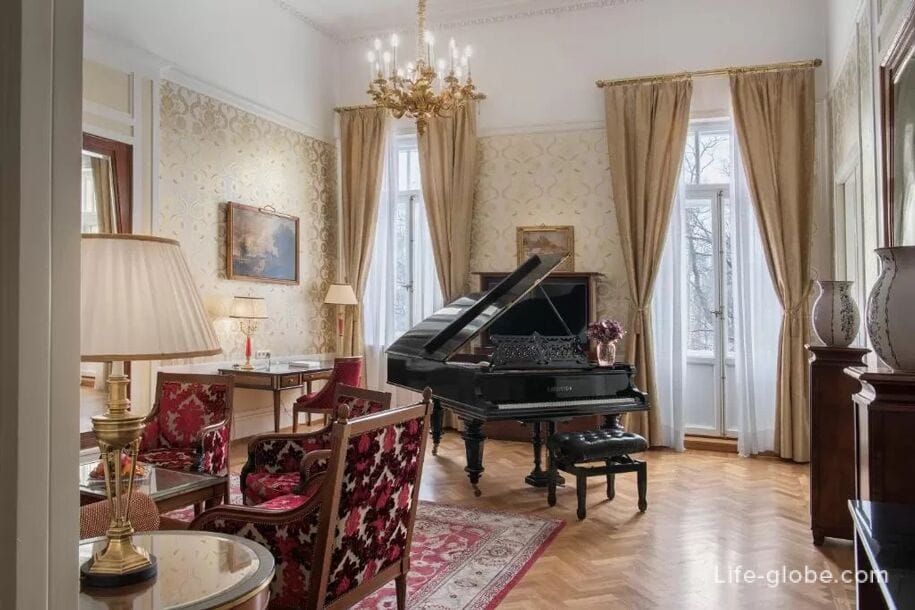
The former building of the Noble Assembly (the current Great Hall of the Philharmonic) was built in 1834-1839 for the Noble Assembly according to the project of K.I. Rossi by architect Paul Jacot.
Since the late 1840s, the hall has become the center of the musical life of St. Petersburg.
The grand opening of the Petrograd Philharmonic took place on June 12, 1921.
Now the Great Hall of the St. Petersburg Philharmonic is one of the best concert halls in Europe.
The Philharmonic also includes the Small Hall named after M.I. Glinka, which is located on Nevsky Prospekt 30 and is considered one of the best chamber halls in the world with unique acoustics.
Address of the Great Hall of the Philharmonic: 2 Italianskaya Street / Mikhailovskaya Street.
Philharmonic website: philharmonia.spb.
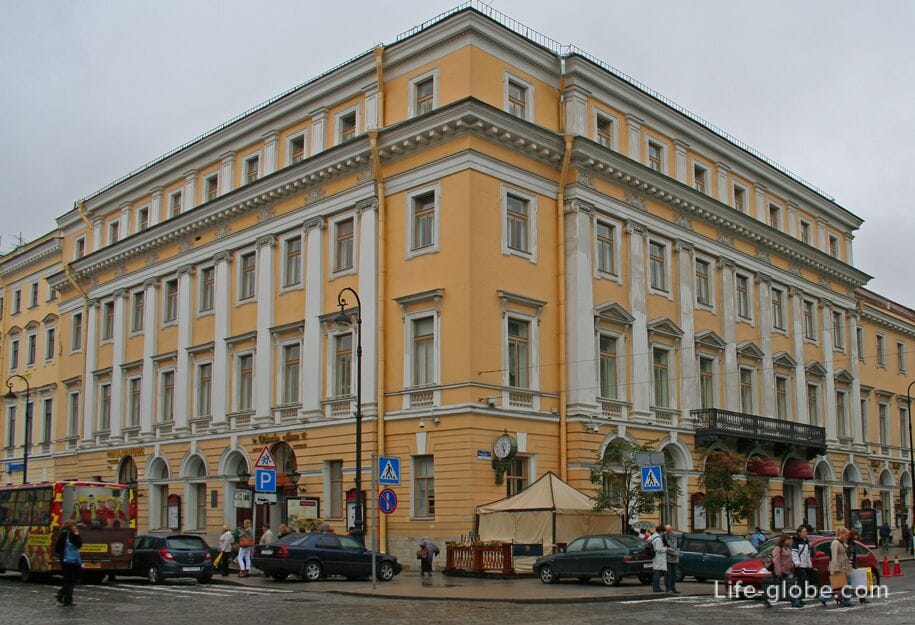

The Lazarev House was built in 1799 by architect Egor Timofeevich Sokolov for a major merchant I. Lazarev as an apartment building.
After a fire in 1910, the building was bought by the treasury, and the interior was rebuilt according to the project of engineers I. Balbashevsky and A. Maksimov for performances of the Palace Theater. In 1929-1934, the building housed a Music hall under the direction of I.O. Dunaevsky.
From 1938 to the present, the St. Petersburg Musical Comedy Theater has been located in the building.
The theater has large and small halls, as well as a foyer. Operettas and musicals form the basis of the repertoire; performances for children are staged.
The address of the theater: Italianskaya Street, 13.
Website of the theater: muzcomedy.
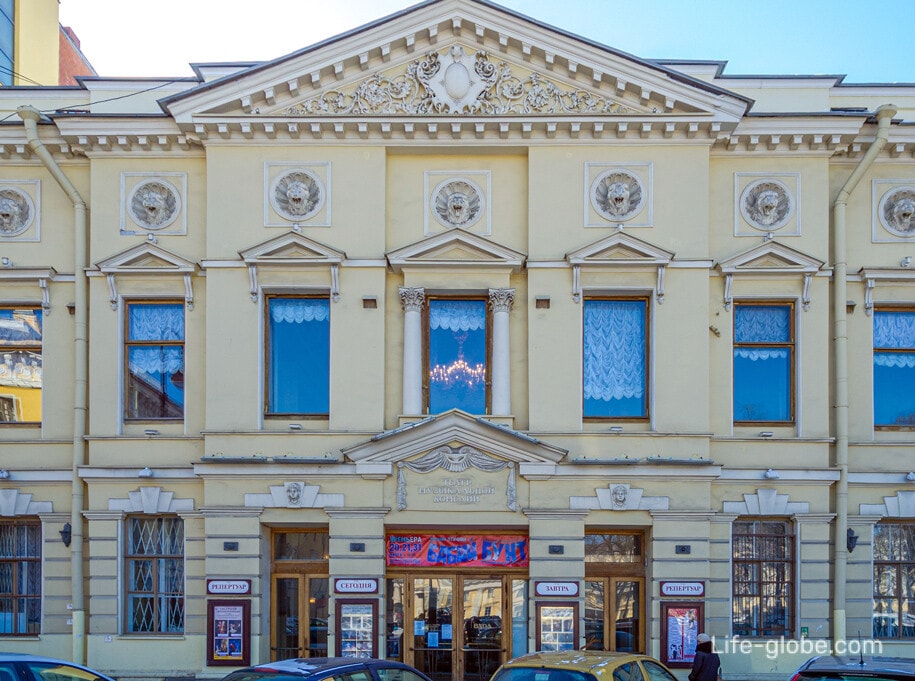
The building was built in 1831 by architect Andrey Mikhailovich Bolotov for Count Matvey Yuryevich Vielgorsky.
In the first half of the 19th century, it was one of the centers of the musical and creative life of St. Petersburg, where many outstanding representatives of art gathered, famous artists and musicians performed.
In 1872, the house was sold by Vielgorsky's daughters, and the building housed Kochkurov's confectionery, which later became a meeting place for revolutionaries and populist terrorists.
In 1993, part of the premises of the Vielgorsky House were transferred to the Russian Gymnasium at the Russian Museum.
Building address: Arts Square, 4/6.
The building was built in 1937 by architect Noah Abramovich Trotsky as a school building.
In 1947, according to the project of architect Alexander Alexandrovich Kedrinsky, the facade of the building was stylized as a general ensemble of the Arts Square.
In 1989, the secondary school was transformed into a Russian gymnasium at the State Russian Museum. Then, on the basis of one of the largest museums in the city, the first Russian educational institution was created, which allowed the joint efforts of teachers and museum workers to solve issues of artistic and aesthetic education and upbringing.
Website of the Russian Gymnasium at the Russian Museum: gymgrm.
Address of the gymnasium: Arts Square, 2/3.
In the photo, the Vielgorsky House and the Gymnasium building at the Russian Museum

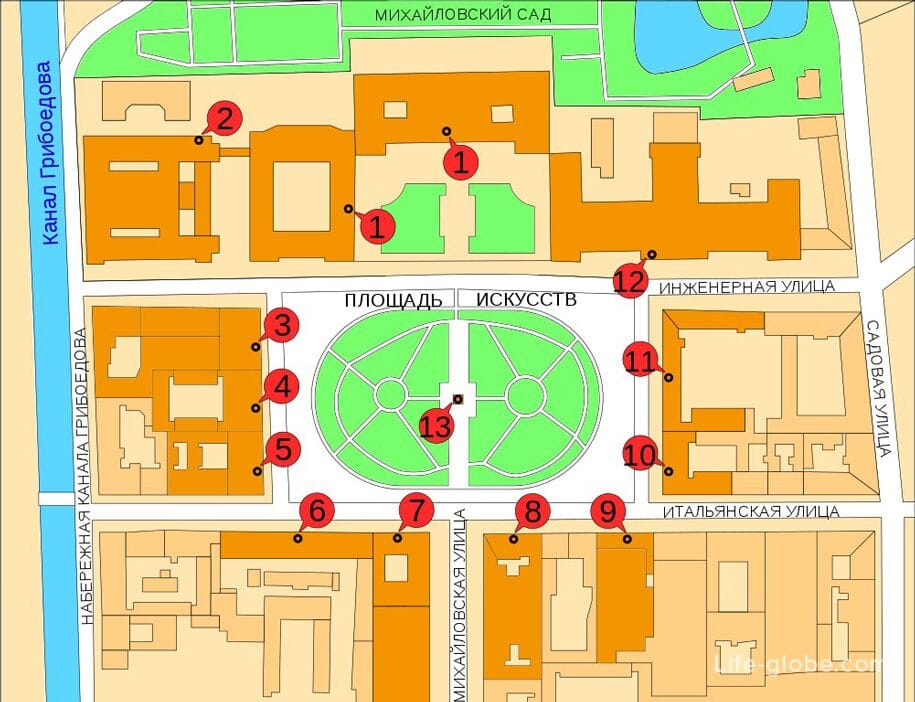
1. Mikhailovsky Palace (Russian Museum)
2. Benois Building (Russian Museum)
3. Mikhailovsky Theatre
4. Golenishchev-Kutuzov House (Brodsky Museum)
5. Jacko's House
6. St. Catherine 's Church House
7. Belmond Grand Hotel Europe
8. Noble Assembly (Great Hall of the Philharmonic)
9. Lazarev House (Musical Comedy Theater)
10. Vielgorsky House
11. The Gymnasium building at the Russian Museum
12. The building of the Russian Ethnographic Museum
13. Monument to A.S. Pushkin
Coordinates of Arts Square: 59°56'14.0"N 30°19'54.0"E (59.937222, 30.331667).
Nearest metro stations: "Nevsky Prospekt", "Gostiny Dvor" and "Admiralteiskaya".
All accommodation facilities in St. Petersburg, including in the city center and more remotely from it, can be viewed and booked here